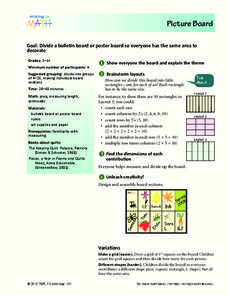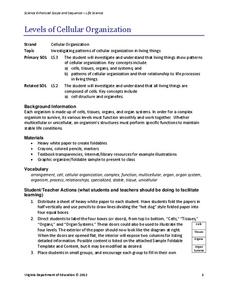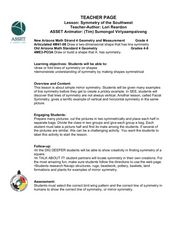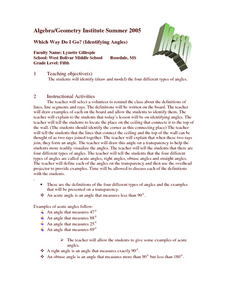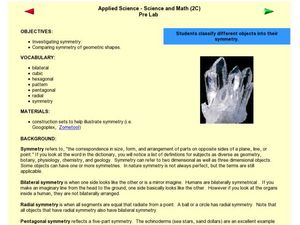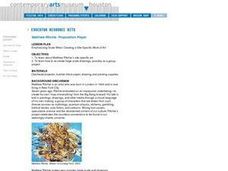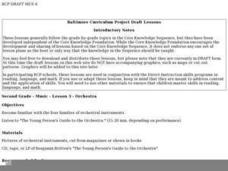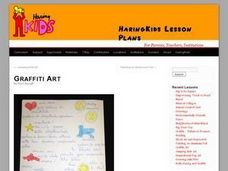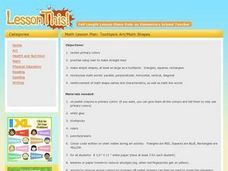Curated OER
Growing Minds: Farm Animal Matching Game
Use this farm animal matching worksheet alongside the Growing Minds Farm Animals lesson; kids learn about different animals and the products they are needed for. This activity highlights cows, bees, geese, chickens, goats, sheep, and...
Curated OER
Picture Board
Learners divide a poster board so everyone gets the same amount of area to decorate. Youngsters talk about the different ways to divide a rectangle. They measure their lines to make sure that each piece is equal and then decorate their...
Curated OER
Call It a Hunch
Give young scholars a chance to practice making inferences after reading the book Through My Eyes by Ruby Bridges. They confirm whether or not their conclusions are true, have a class discussion, and then independently complete an...
Curated OER
The Search for Centimeters
Investigate the length of various objects in metrics! In this measurement lesson, 2nd graders estimate and find the length of objects in the classroom using centimeters.
Utah Education Network (UEN)
Values
Being self-aware of personal wants, needs, and values is a big part of growing up. Here, you'll find seven different teaching options and two different introductions to a lesson on getting learners to think about their personal values....
Virginia Department of Education
Levels of Cellular Organization
What an eccentric way to learn about each level of cellular organization! Allow emerging biologists to utilize white paper and create their own foldable charts to describe each level of organization in the body. You may also adapt the...
Virginia Department of Education
Logic and Conditional Statements
If there is a conditional statement, then there is a hypothesis and conclusion. Pupils learn how to identify the parts of conditional statements. Class members continue to work with conditional statements and rewrite them in their many...
Curated OER
Mystery State #32
There is no better way to start a lesson, than with a good problem-solving activity. Give your class the chance to see if they can use each of the five clues to determine the name of mystery state number 32. Hint: It's the eastern most...
Curated OER
Be Kind to Your Teeth
What kinds of food can be bad for your teeth? Kindergartners and first graders explore dental health with an interactive science inquiry. Given a choice of foods such as celery, cake, and milk, kids choose which ones are better for their...
Freeology
Lowercase Letter a Coloring
Help young learners master their alphabet with this simple series of worksheets. Including a separate worksheet for each letter of the alphabet, children first trace the letters four times before writing them on their own and...
University of Notre Dame
The Natural Exponential Function
Ready to apply the concepts related to the natural exponential equations and logarithmic equations? A math lesson reviews concepts from inverse properties to solving to derivatives and integrals.
Curated OER
Cows on Parade
Students use assorted drawing materials and sheets from a cow shaped pad to create a unique, bright, colorful cows.
Curated OER
Exploring Geometric Patterns and Relationships
Sixth graders explore different geographic relationships in like drawing lines, rays, and parallelograms. This lesson plan could be used for review because it covers more than one concept. The students should have prior knowledge.
Curated OER
Symmetry of the Southwest
Fourth graders examine mirror symmetry. In this symmetry lesson, 4th graders discover that symmetry is not always vertical or horizontal. Students cut and fold shapes along lines of symmetry.
Curated OER
Which Way Do I Go? (Identifying Angles)
Fifth graders practice the concepts related to finding and identifying different angles. There are examples included in the lesson that are useful for the teacher to deliver the lesson.
Curated OER
Symmetry
Sixth graders explore symmetry and discuss the difference between a rotation and reflection. Using hands-on activities, such as folding paper shapes, they discover how to find the lines of symmetry and symmetrical characteristics. As a...
Curated OER
Emphasizing Scale When Creating a Site-Specific Work of Art
Students study art by Matthew Ritchie. Students view pictures of the artist and discuss art that is created specifically for a designated area. Students create pen and ink drawings on letter size paper. Using an overhead, students...
Curated OER
Music - Lesson 3 - Orchestra
Second graders study the four families of orchestral instruments and patriotic songs in this unit of lessons.
Curated OER
A Bird's-eye View
Sixth graders create a chalk drawing of a scene of their choice by using the process and techniques of horizon line, a variety of lines, vanishing points, and three-dimensional techniques.
Curated OER
Graffiti Art
High schoolers become exposed to the art work of Keith Haring and create a piece of graffiti art. For this graffiti art lesson, students discover Keith Haring's work in a historical context, explore the usage of lines and...
Curated OER
Longitude
In this globe worksheet, students learn how longitude is measured on a globe. Students read the information before answering 5 questions. A globe will be required.
Curated OER
Conjectures For Intersecting Circles
Students identify properties of circles. In this geometry lesson, students identify the center of two intersecting circles.They use Cabri software to create circles and move it around to make observation.
Curated OER
Toothpick Art
Students review primary colors and practice making straight lines. In this visual arts lesson, students paint simple shapes as large as a toothpick, using specific primary colors. During the construction of the shapes students are...
Curated OER
Lady Liberty
Learners discussed symbolism, freedom and the Statue of Liberty. They explored Keith Haring's style. They used colored markers, color, and line to draw a Statue of Liberty.

